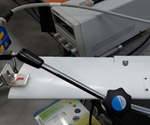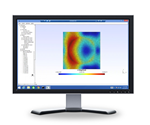AnalySwift launches VABS software on Altair Partner Alliance platform
VABS software enables cost-effective simulation for composite rotor blades, tubes and other slender composite structures.

Source | AnalySwift
Analyswift LLC (West Jordan, Utah, U.S.), a provider of high-fidelity modeling software for composites and other advanced materials, announced on June 16 that it has joined Altair Engineering’s (Troy, Mich., U.S.) Altair Partner Alliance (APA), a platform that offers on-demand access to a broad spectrum of software applications. AnalySwift’s VABS simulation software is the latest addition to the APA.
VABS is a general-purpose, cross-sectional analysis tool for composite rotor blade modeling, wing section design and simulation of other slender composite structures. Used in several industries, it is said to be able to accurately compute the complete section of beam sectional properties for slender structures, such as propellors, wing sections, landing gear, golf club shafts, fishing rods and prosthetics. In addition to calculating sectional properties for composite structures like tubes, columns, shafts and bridges, VABS is also said to calculate structural properties — torsional stiffness, bending stiffness and all couplings — which predict 3D displacements, stresses and strains at the ply level, and can be used independently for structural design of beam sections in terms of topology or materials. Further, the program includes multiple beam models for composites, including the Euler-Bernoulli and Timoshenko models, and the Vlasov model to deal with trapeze effect and oblique sections. Overall, AnalySwift says it is a cost-effective method that can achieve the fidelity of 3D finite element analysis (3D FEA), while saving on computing time.
AnalySwift says the simulation software originated from the U.S. Army’s need for a tool that could accurately model composite helicopter rotor blades. For an accurate design, 3D FEA requires at least one solid element per layer, but the analysis becomes computationally prohibitive due to the degree of freedom involved. And to get calculate torsional behavior and transverse shear stress, four to six elements per layer are required, not just one, rendering the computation impossible. To overcome this, engineers either resort to shell elements or use a smeared properties approach, in which they smear a stack of laminates to become a sort of “black aluminum” and treat it as a homogeneous material. AnalySwift says shell elements, however, don’t work well for this and using smeared properties compromises accuracy.
VABS overcomes the limitations of these approaches, only taking a few seconds to run on a laptop computer while accurately calculating the ply-level details of the blade. VABS works by rigorously decoupling the original 3D problem into a 2D cross-sectional analysis and 1D beam analysis. The software handles the 2D cross-sectional analysis, which provides the structural and inertia properties for the beam analysis.
Now launched to the APA platform, VABS is integrated with the Altair software suite, including HyperMesh and OptiStruct products. Altair is offering an on VABS, scheduled for July 9, 2020.
Related Content
-
We4Ce infused 2.5-3-MW rotor blade design passes validation test
Composite rotor blade structure design by We4Ce, mold and prototype production by InDutch Composites and fatigue testing by Suzlon Group has resulted in the novel blade’s IEC61400-5:2020 certification.
-
Infinite Composites: Type V tanks for space, hydrogen, automotive and more
After a decade of proving its linerless, weight-saving composite tanks with NASA and more than 30 aerospace companies, this CryoSphere pioneer is scaling for growth in commercial space and sustainable transportation on Earth.
-
ZEBRA project demonstrates closed-loop wind recycling system
Consortium partners have proven the complete recycling of thermoplastic wind turbines via two manufactured wind blades, featuring reduced operating cost, CO2 emissions.






